Siberian Huskies are well-loved for their striking appearance, high energy levels, and friendly nature.
Understanding their growth patterns is essential for ensuring their health and well-being. This Siberian Husky growth chart delves into the various stages of a Husky’s growth.
It details the weight and height changes from puppyhood to adulthood and highlights key factors influencing their development.
With a focus on health issues, nutrition, and proper care, this comprehensive guide about the Husky growth chart aims to provide everything you need to know about when Siberian Huskies stop growing and the best way to track their body size.
So let’s get into how big a Siberian Husky gets!
Male vs. Female Husky Growth Chart

In this part, we’ll explore just how big Siberian Huskies get, complete with a height chart and healthy weight ranges for both male and female Huskies.
Typically, male Huskies are larger and more robust than their female counterparts. By six months, male Huskies generally reach about 18 inches at their shoulder and weigh around 30 pounds, resembling fluffy, hyperactive mini-wolves.
Female Huskies, a bit more delicate, usually reach 16 inches in height and weigh around 28 pounds at this age.
The height difference is pretty clear, but what’s even more fun is their personalities evolving! Male Huskies often take the lead in playful chaos, while females, slightly more reserved, might sit back and let the boys wear themselves out.
When fully mature, male Huskies keep their size advantage, typically growing from 21 to 23.5 inches in height while weighing 45 to 60 pounds. They continue to resemble well-built athletes, always ready for an adventure.
Conversely, females grow from 20 to 22 inches when talking about height and weigh between 35 to 50 pounds, maintaining a sleeker, more elegant build.
So, while your male Husky might be the neighborhood clown, always up to some goofy antics, your female Husky could be the queen, watching over her domain with a bit more sophistication.
Either way, both are bound to bring joy, laughter, and a bit of mayhem to your home!
Male Husky Weight And Height Chart
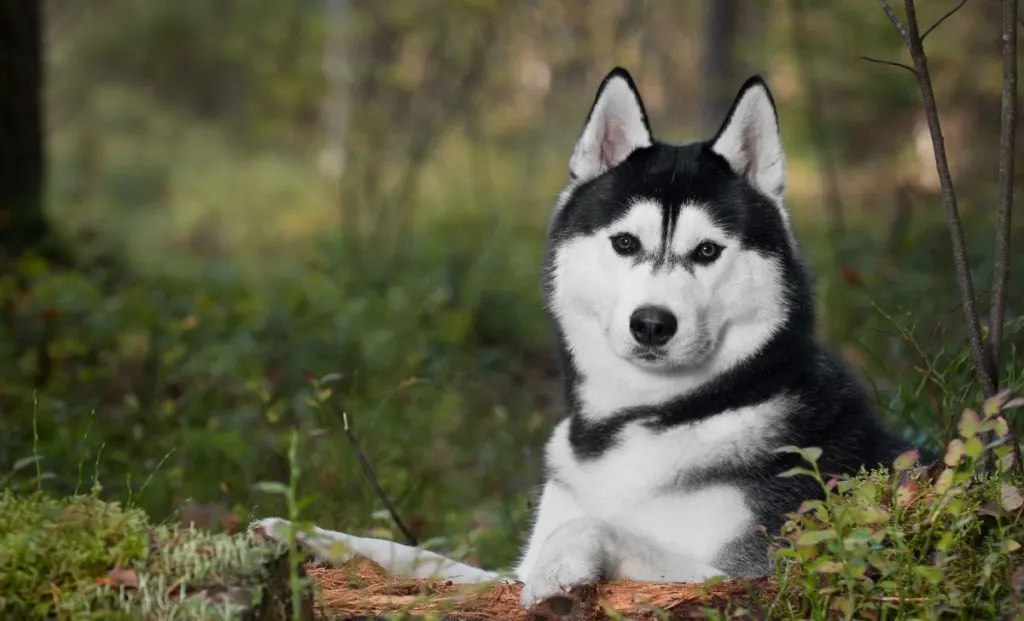
Understanding the weight and height progression of a male Siberian Husky is crucial for ensuring their healthy development.
This chart provides an approximate weight range for male Huskies at various stages of growth, helping owners monitor and manage their pet’s health effectively.
All the information was sourced from the American Kennel Club (AKC).
Weight Chart
| Age (Months) | Average Weight (pounds) |
|---|---|
| 1 | 3 – 5 |
| 2 | 10 – 15 |
| 3 | 23 – 30 |
| 4 | 27 – 34 |
| 5 | 30 – 38 |
| 6 | 33 – 43 |
| 7 | 35 – 47 |
| 8 | 38 – 50 |
| 9 | 40 – 53 |
| 10 | 42 – 55 |
| 11 | 44 – 57 |
| 12 | 46 – 60 |
| 18 | 50 – 65 |
| 24 | 50 – 65 |
Height Chart
| Age (Months) | Average Height (inches) |
|---|---|
| 1 | 4 – 6 |
| 2 | 8 – 10 |
| 3 | 10 – 12 |
| 4 | 12 – 14 |
| 5 | 14 – 16 |
| 6 | 16 – 18 |
| 7 | 17 – 19 |
| 8 | 18 – 20 |
| 9 | 19 – 21 |
| 10 | 20 – 22 |
| 11 | 21 – 23 |
| 12 | 21 – 23 |
| 18 | 21 – 24 |
| 24 | 21 – 24 |
Female Husky Weight And Height Chart
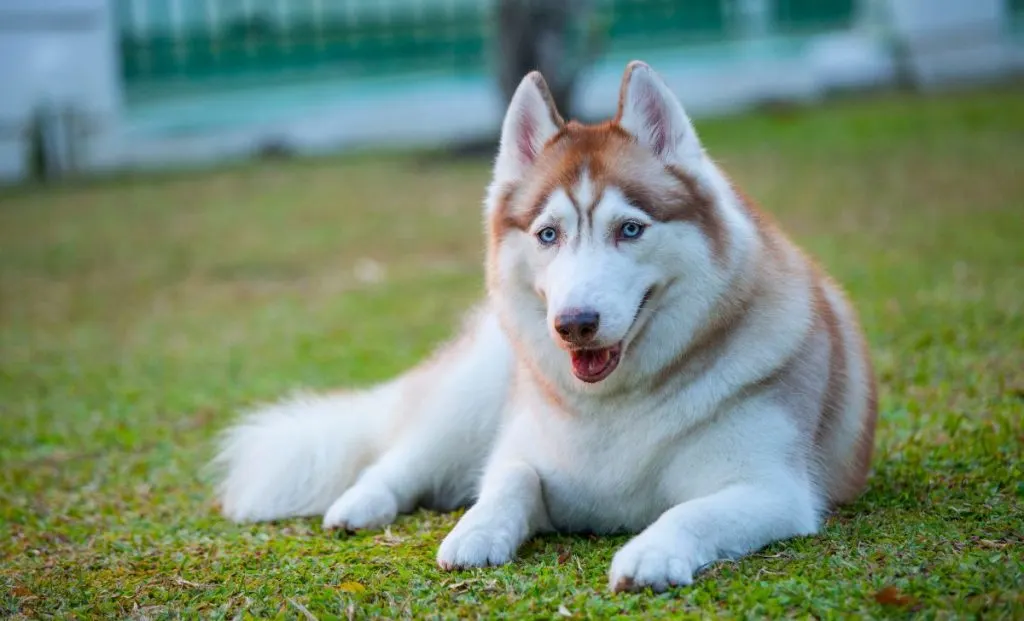
Understanding a Siberian Husky’s female weight and height progression is crucial for ensuring their healthy development.
This chart provides an approximate weight range for female Huskies at various stages of growth, helping owners monitor and manage their pet’s health effectively.
All the data points were sourced from the American Kennel Club (AKC).
Weight Chart
| Age (Months) | Average Weight (pounds) |
|---|---|
| 1 | 2 – 4 |
| 2 | 8 – 12 |
| 3 | 18 – 25 |
| 4 | 22 – 28 |
| 5 | 25 – 34 |
| 6 | 28 – 38 |
| 7 | 30 – 42 |
| 8 | 32 – 44 |
| 9 | 34 – 46 |
| 10 | 36 – 48 |
| 11 | 37 – 49 |
| 12 | 38 – 50 |
| 18 | 35 – 55 |
| 24 | 35 – 50 |
Height Chart
| Age (Months) | Average Height (inches) |
|---|---|
| 1 | 4 – 6 |
| 2 | 7 – 9 |
| 3 | 9 – 11 |
| 4 | 11 – 13 |
| 5 | 13 – 15 |
| 6 | 15 – 17 |
| 7 | 16 – 18 |
| 8 | 17 – 29 |
| 9 | 18 – 20 |
| 10 | 19 – 21 |
| 11 | 19 – 21 |
| 12 | 20 – 22 |
| 18 | 20 – 22 |
| 24 | 20 – 22 |
Husky Development Stages

Raising a Husky is like embarking on a roller-coaster ride filled with boundless energy, snowy mischief, and endless snuggles.
It is a journey where every day brings a new adventure, from the curious antics of a mischievous pup to the majestic grace of a full-grown companion.
Let’s dive into the exhilarating stages of your Husky’s development, capturing each heartwarming moment as they grow from a little bundle of fur into your loyal, howling partner in crime.
Get ready for a fun, engaging, and unforgettable experience with your Husky!
0 – 2 Months
In the first few weeks of life, Siberian Husky puppies undergo rapid growth and development.
At birth, they typically weigh between 0.8 to 1.3 pounds. During these early months, puppies heavily rely on their mother’s milk, which provides the necessary nutrients for their initial growth.
By the end of the second month, a typical Husky puppy weighs around 10-15 pounds.
2 – 4 Months
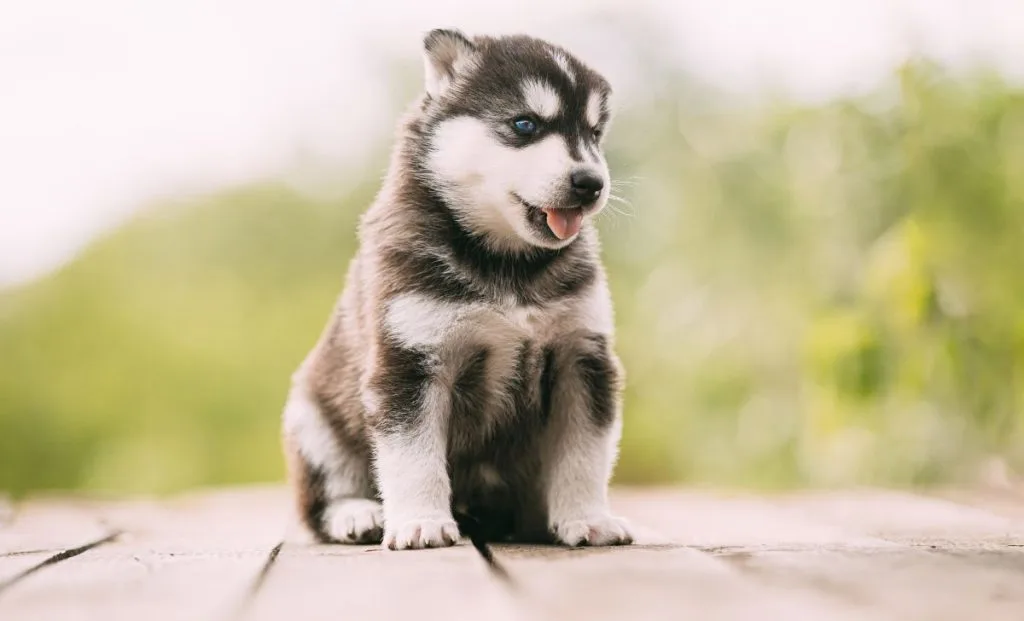
From two to four months old, Husky puppies experience significant physical and behavioral changes.
The puppies begin to explore their surroundings and develop social skills.
Their weight increases rapidly, with females generally weighing 20-30 pounds and males 25-35 pounds by the end of this period.
Proper nutrition during this stage is crucial for their bone and muscle development. High-quality puppy food formulated for large breeds helps meet their nutritional needs.
4 – 6 Months
Between four to six months, Huskies continue to grow rapidly.
Males may weigh 30-40 pounds, while females usually weigh 25-35 pounds. This stage is marked by teething and increased physical activity.
Ensuring they receive enough calcium and phosphorus is essential for healthy bone development.
It’s also a good time to start basic obedience training to instill good behavior early on.
6 – 12 Months
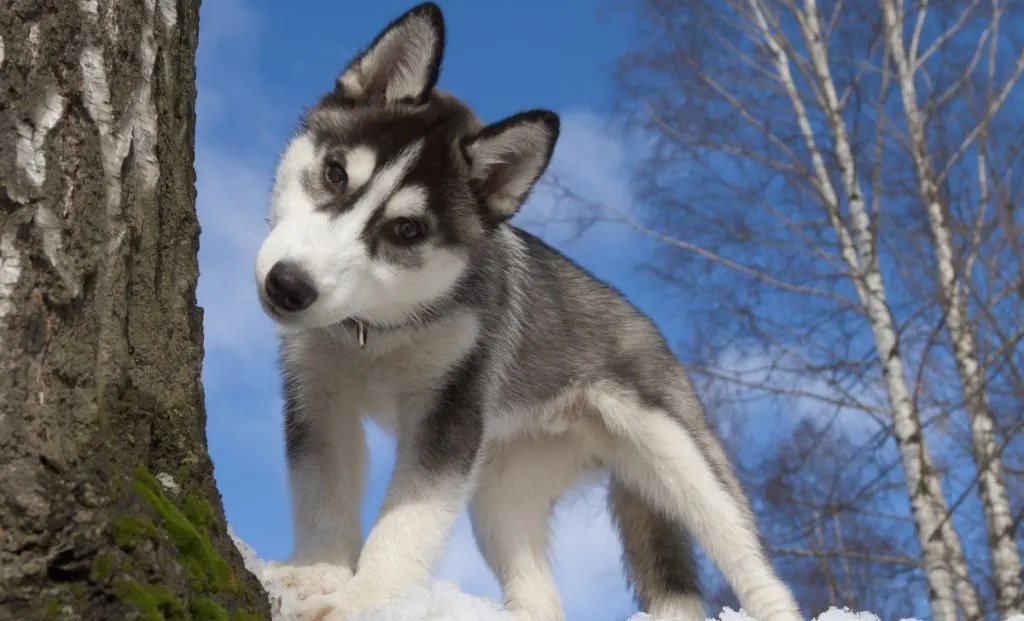
During this stage, Huskies’ growth rate begins to slow, but they continue steadily gaining weight and height.
By their first birthday, males typically weigh 45-60 pounds and females between 35-50 pounds.
They also reach about 85-95% of their full height. Proper nutrition and regular exercise remain vital to support their development and prevent obesity.
12 – 24 Months
From one year to two years, Huskies transition from adolescence to adulthood.
They reach their full height, with males standing around 21-24 inches tall and females 20-22 inches.
Their weight also stabilizes, with males averaging 50-60 pounds and females 40-55 pounds.
This period is crucial for mental and physical maturity. Consistent training and a balanced diet help maintain their healthy weight and overall well-being.
Adult Height And Weight
Adult Siberian Huskies typically weigh 45 – 60 pounds for males and 35 – 50 for females.
Their adult height ranges from 20 – 24 inches. Genetics, diet, and exercise significantly determine their final size.
Ensuring the dogs receive proper nutrition and regular veterinary check-ups helps maintain their healthy weight and prevent potential health issues.
Factors Influencing Growth
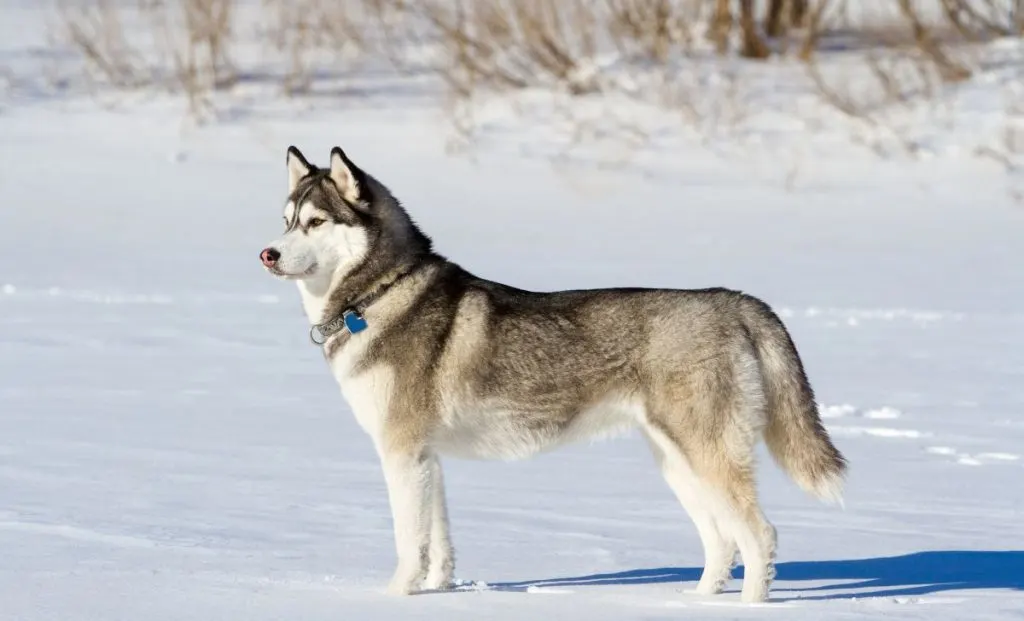
Genetics
Genetics is the primary determinant of a Husky’s growth.
Purebred dogs from healthy, well-bred lines are more likely to grow into robust adults.
Acquiring Huskies from reputable breeders who prioritize health and genetics is essential.
Nutrition
Proper nutrition is crucial for Huskies’ healthy growth. High-quality dog food rich in proteins, fats, vitamins, and minerals supports their development.
It’s important to adjust their food intake based on weight, age, and activity level to prevent under or overfeeding.
Exercise
Huskies are active, working dogs (sled dogs) that require much exercise to support their fast growth and maintain a healthy weight.
Physical activities like running, hiking, and playing help build strong muscles and prevent obesity.
However, over-exercising puppies can damage their developing joints, so balancing activity levels appropriately is important.
Health Issues
Siberian Huskies are generally healthy pups; however, they are susceptible to health problems that can affect their development and growth.
Common problems include hip dysplasia, progressive retinal atrophy (PRA), and hypothyroidism.
Regular veterinary check-ups and early diagnosis can help manage these conditions and support healthy development.
Maintaining a Healthy Lifestyle

Proper Nutrition
It is crucial to feed Huskies a balanced diet tailored to their life stage.
Puppy food for young dogs, adult food for mature dogs, and senior food for older dogs help meet their specific nutritional needs at different points in their lives.
High-quality commercial dog food, homemade diets under veterinary guidance, and raw diets are popular among Husky owners.
Regular Exercise
Huskies have high energy needs and require regular exercise to stay healthy. Daily activities like running, walking, and playing are essential.
Engaging in activities like sledding or agility training can provide both mental stimulation and physical exercise, keeping them fit and happy.
Health Monitoring
Regular veterinary check-ups are important to monitor Huskies’ health and catch potential issues early.
Vaccinations, dental care, and routine screenings help prevent common health problems and ensure a long, healthy life.
Managing Weight
Maintaining an ideal and healthy weight is a good idea for preventing obesity-related health issues.
Monitoring food intake, providing appropriate portions, and ensuring regular exercise help manage their weight effectively.
Avoiding high-calorie treats and table scraps also helps keep their weight in check.
Possible Medical Issues

Hip Dysplasia
Hip dysplasia is quite common in larger dog breeds, including the big Husky breed.
It happens when the dog’s hip joint doesn’t develop properly, leading to arthritis and pain.
Regular exercise, joint supplements, and maintaining a healthy weight can help manage this condition.
Progressive Retinal Atrophy (PRA)
PRA is a genetic health issue that affects the eyes, leading to gradual vision loss. Regular eye check-ups can help in detecting PRA early.
Although there is no cure, managing the condition with the help of a veterinarian can improve the quality of life for affected dogs.
Hypothyroidism
Hypothyroidism occurs when the dog’s thyroid gland does not make or produce enough hormones.
This can lead to issues like weight gain, lethargy, and skin issues. Regular blood tests can diagnose this condition, and daily medication can manage it effectively.
Normal Growth Rate For A Husky Puppy
A Husky puppy grows like a fluffy, energetic weed.
In the first couple of weeks, they typically double their birth weight. By three months, your male Husky might tip the scales at 18-25 pounds, while the females might be a more modest 15-20 pounds.
Growth spurts are common in the first six months, but after that, it’s like they take a deep breath and slow down a bit, continuing to grow until they reach their majestic full size at around 18 – 24 months.
Keep an eye on their weight and ensure they’re getting the right nutrition, and you’ll have a happy, healthy pup on your hands!
How Can I Tell If My Husky Is Underweight Or Overweight
Think of your Husky’s ribs like a well-hidden treasure. You should be able to feel them without pressing too hard, but they shouldn’t be on full display like a pirate’s chest at a theme park.
If you see the ribs clearly, your pup might be underweight, and if they’re buried deep beneath layers of fluff and fat, your Husky might be carrying a bit of extra cargo.
To determine if your Husky is underweight, observe their overall body condition. If you can see their ribs, spine, or pelvic bones, your Husky is likely underweight.
This can be due to poor nutrition, illness, or increased physical activity without sufficient calorie intake. Underweight Huskies often have less muscle mass, their muscles might feel less firm, and their body may appear more angular.
Conversely, to assess if your Husky is overweight, check for excess fat covering. If you need to press hard to feel their ribs, your Husky might be overweight.
Excess fat around the ribs and a lack of a visible waistline when viewed from above are key indicators. Overweight Huskies may have noticeable fat deposits over the lower back and base of the tail.
Additionally, overweight dogs often show less interest in physical activities due to the extra weight burdening their joints and overall health.
Regular weigh-ins and a friendly chat with your vet can help keep your Husky in tip top shape.
A veterinarian can provide a detailed body condition score (BCS) and give tailored advice on diet and exercise to ensure your Husky maintains a healthy weight.
Sings Of Health Related Issues In Huskies
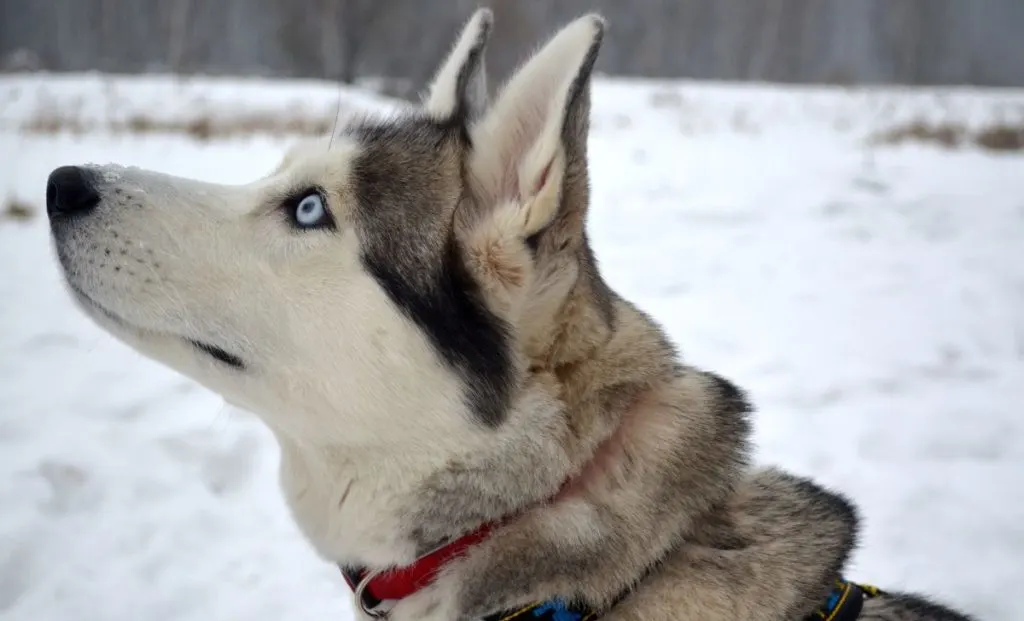
A healthy Husky should bounce around like a furry ball of energy. If your pup starts limping, stiffening up, or acting like they’d rather nap than play, it might indicate joint issues like hip dysplasia.
Limping or stiffness can signal hip dysplasia or arthritis, common issues in Huskies that can lead to significant discomfort if not managed properly. Difficulty standing or walking, especially on stairs, could also be a sign of joint pain.
Sudden weight loss can indicate problems such as thyroid issues, gastrointestinal problems, or parasites. It can also be a sign of poor nutrition.
On the other hand, significant weight gain can point to hypothyroidism, a common issue in Huskies where the thyroid gland doesn’t produce enough hormones, leading to weight gain, lethargy, and skin problems.
If your Husky isn’t growing as fast as their littermates, there could be an underlying health issue. Nutritional deficiencies, genetic factors, or chronic illnesses can affect growth rates.
Additionally, a healthy Husky should have a thick, shiny coat. Dull and dry fur, excessive shedding, or skin problems can indicate nutritional deficiencies or other health issues.
Regular vet visits are like hitting the refresh button on your Husky’s health, ensuring they grow up strong and spirited.
These check-ups allow for early detection of potential health issues and help in maintaining a balanced diet and appropriate exercise regimen tailored to your Husky’s needs.
By monitoring their physical condition and behavior closely, you can ensure your Husky stays healthy and happy.
To Sum It All Up
Understanding the growth patterns and needs of Siberian Huskies is essential for providing the best care.
From their early months as tiny, energetic furballs to their majestic adulthood, each stage requires attention to their unique needs.
Proper nutrition fuels their boundless energy, regular exercise keeps their agile bodies in top form, and routine health monitoring ensures any issues are caught early.
This comprehensive guide is designed to help your Husky flourish into a healthy, happy, and well-adjusted adult.
With love and care, your Husky will thrive, becoming a loyal and loving companion for years.
Their spirited personality and unwavering loyalty will bring joy and warmth to your life, making every moment together a cherished memory.

Nandina has been a lifelong dog owner and enthusiast. She shared her home with multiple breeds, including Giant Schnauzers, Cane Corsos, and Huskies. Currently, she is raising a three-year-old rescue and a working-line German Shepherd puppy.
Actively engaged in IGP dog sports for two years, Nandina is a certified instructor for basic obedience and socialization. She works as a trainer in her local dog sports club, and in her spare time, she handicrafts biothane gear for dogs.
